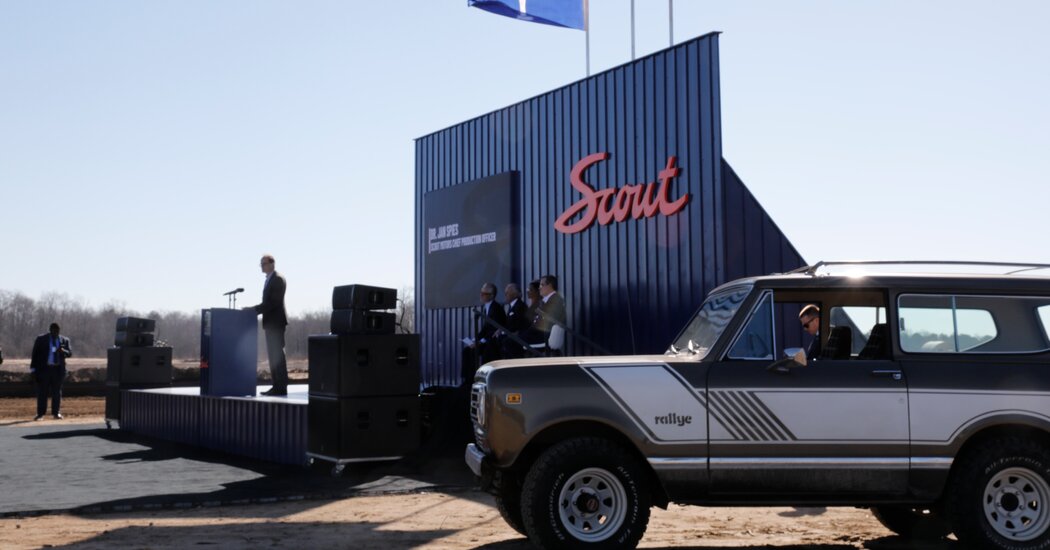Probably only Americans of a certain age remember when the Volkswagen Beetle was the best-selling imported car in the United States and the hippest ride to a Grateful Dead concert was a Volkswagen Microbus.
Volkswagen is trying to tap some of that nostalgia in its latest push to regain the status and sales it enjoyed in the United States during the Beetle’s and Microbus’s heydays in the 1960s. But this time it hopes its top models will be electric.
The German carmaker is second only to Toyota globally but is a niche player in the United States. Part of its plan to revive its fortunes here is to lean on a new electric model that resembles the Microbus, the ID.Buzz, and to revive the Scout brand with a line of electric pickups and sport utility vehicles.
Last week, as giant earth movers kicked up clouds of dust, Volkswagen executives and local officials gathered near Columbia, S.C., to inaugurate the site of a factory that will build vehicles bearing the Scout badge for the first time since 1980.
Volkswagen is one of several foreign automakers that see electric cars and the upheaval they are causing as a way to challenge the dominant players in the United States. Volkswagen, which also owns Audi, Porsche, Bentley and Lamborghini, is aiming to at least double its market share in the United States by the end of the decade from a meager 4 percent now.
“This market is turning electric, and everybody’s starting from scratch,” Arno Antlitz, the chief financial officer of Volkswagen, said in an interview. “This is our unique opportunity to grow.”
Electric vehicles have already shaken the industry rankings, emboldening Volkswagen and other foreign automakers. Battery-powered S.U.V.s and sedans helped Hyundai Motor and its sister brand Kia overtake Stellantis, the maker of Jeep, Dodge, Chrysler and Ram, as the fourth-largest carmaker by sales in the United States last year.
“Electric vehicles are helping our brand to be seen as a technology leader,” said José Muñoz, chief operating officer of Hyundai. They also attract a better-educated, more affluent customer than has been the case for the South Korean company’s gasoline vehicles, he said in an interview.
The list of companies that dominate electric car sales looks a lot different from the top rankings for overall U.S. sales, hinting at a future when a different group of companies rule.
The top five companies in the United States for all engine types are General Motors, Toyota, Ford Motor, Hyundai and Stellantis. In electric cars, Tesla is No. 1 by a wide margin, followed by Hyundai, G.M., Ford and Volkswagen. Toyota is a minor player in electric cars.
“Just because you’ve been around for 120 years doesn’t mean you’re going to have anything in this new market,” said Steven Center, the chief operating officer of Kia America.
Volvo Cars is another company hoping to take advantage of the changes wrought by electric vehicles. The Swedish carmaker, which is majority owned by Geely Holding Group of China, reported a 26 percent increase in U.S. sales last year.
Much of that growth came from hybrids that have a gasoline engine and can travel shorter distances on batteries. But Mike Cottone, president of Volvo Car for the United States and Canada, said he saw hybrids as a pathway to fully electric vehicles.
Later this year, Volvo will begin selling a Chinese-made, all-electric compact S.U.V., the EX30, which will start at $35,000. The company will also begin delivering the EX90, a seven-seat S.U.V. that is made in South Carolina and will start around $80,000.
Especially for luxury car buyers, Mr. Cottone said, “there’s a lot of room for growth in the E.V. segment over the next few years.”
Volkswagen has tried and failed since the 1970s to become a bigger presence in the United States, and analysts are skeptical that this time will be different. “I’ve seen Volkswagen set these goals before,” said Michelle Krebs, executive analyst at Cox Automotive.
The established carmakers will not be pushovers. G.M. and Ford are also investing heavily in electric vehicles, while Toyota has said it will start producing a large electric S.U.V. in Kentucky next year.
Ms. Krebs pointed out that auto sales in the U.S. were growing slowly, making the fight for market share largely a zero-sum game. “There’s this little bit of growth that everybody is going after,” she said.
Volkswagen’s last big push in the United States ended in scandal. In the early 2000s, the company tried to sell Americans on cars with “clean diesel” engines. It advertised the fuel, which was used in European passenger cars much more than in American cars, as more environmentally friendly than gasoline.
But the campaign collapsed in 2015 when U.S. regulators discovered that Volkswagen had used software in the vehicles to cheat on emissions tests. In reality, the cars polluted as much as long-haul trucks.
The scandal had one benefit for Volkswagen. It prompted the company to invest early in electric vehicle technology and build cars that were designed from the ground up to run on batteries, rather than make awkward modifications to gasoline models. In Europe, Volkswagen’s various electric brands together outsell Tesla, according to Schmidt Automotive Research.
The person responsible for doubling Volkswagen sales in the United States is Pablo Di Si, president of Volkswagen Group of America. Mr. Di Si, originally from Argentina, said he planned to use the same strategy he deployed while overseeing the company’s operations in Brazil, where Volkswagen’s market share rose to more than 16 percent from 9 percent.
“You look at the segments that you think are going to be successful 10 years from now,” Mr. Di Si said in an interview. “What are your gaps in the product portfolio? And then you start adding products for those particular markets.”
In the United States, he said, that is likely to include gasoline cars and hybrids as well as all-electric vehicles. Volkswagen plans to import the ID.7, an electric sedan, and the ID.Buzz. Mr. Di Si hinted that there might also be a new electric vehicle that references the design of the Beetle. The last version of that car sold in the United States was the 2019 Beetle.
Volkswagen is building a $5 billion factory in Ontario to supply batteries to its factories in Chattanooga, Tenn., and Puebla, Mexico, which together will produce at least 80 percent of the company’s cars sold in North America. That will help buyers of cars from its Volkswagen, Audi and other brands qualify for federal tax credits of up to $7,500 per car.
Scout will fill a major gap in Volkswagen’s portfolio: pickups, among the most popular vehicles in the United States. By reviving Scout, which was one of the first passenger vehicles that could navigate rough dirt tracks as well as city streets, Volkswagen hopes to attract buyers who typically buy off-road-capable vehicles from U.S. brands like Chevrolet, Ford and Jeep.
The South Carolina factory will underscore the made-in-America vibe when the first Scouts go on sale in late 2026. Volkswagen inherited the Scout brand when the company’s truck subsidiary, Traton, acquired Navistar, a U.S. company previously known as International Harvester, in 2021.
The new Scouts may borrow some parts used in other Volkswagen vehicles, company executives said, but the design will be distinct from existing vehicles like the electric ID.4 S.U.V. made in Chattanooga. Scout plans to reveal prototypes this year.
A stronger presence in the United States is “a strategic necessity,” Scott Keogh, the chief executive of Volkswagen’s Scout Motors division, said in South Carolina last week.
Outside the United States, Volkswagen is a behemoth, with a 26 percent share of the European market and 15 percent in China. But the company is under severe pressure in China, where sales of electric vehicles have been growing fast, allowing BYD and other Chinese carmakers to gain market share from foreign automakers. Volkswagen needs growth in the United States to compensate.
Volkswagen “wants to have a strong global footprint,” Mr. Keogh said, “not have an isolated footprint, where it’s only sitting strong in one region.”



